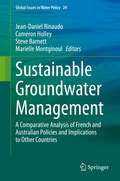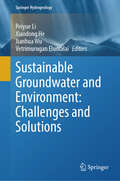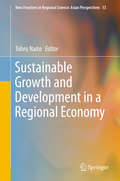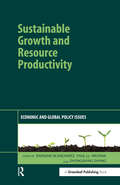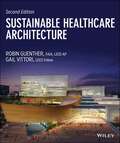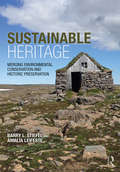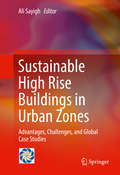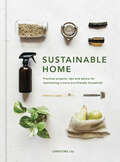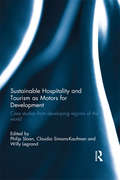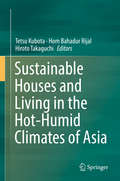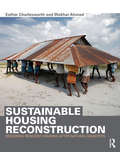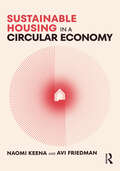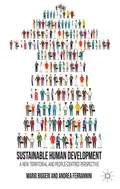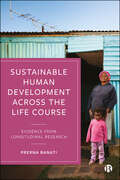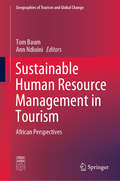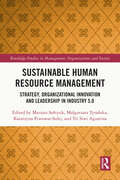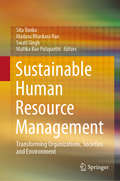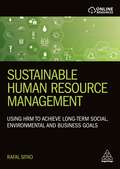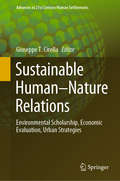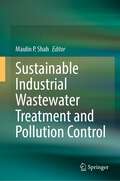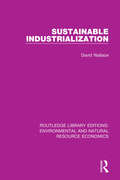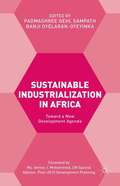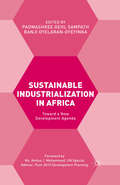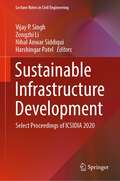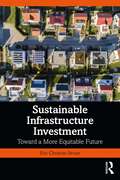- Table View
- List View
Sustainable Groundwater Management: A Comparative Analysis of French and Australian Policies and Implications to Other Countries (Global Issues in Water Policy #24)
by Steve Barnett Jean-Daniel Rinaudo Cameron Holley Marielle MontginoulThis book describes and analyses the diversity of possible approaches and policy pathways to implement sustainable groundwater development, based on a comparative analysis of numerous quantitative management case studies from France and Australia.This unique book brings together water professionals and academics involved for several decades in groundwater policy making, planning or operational management to reflect on their experience with developing and implementing groundwater management policy. The data and analysis presented accordingly makes a significant contribution to the empirical water management literature by providing novel, real world insights unpublished elsewhere. The originality of the contributions also lies in the different disciplinary perspectives (hydrogeology, economics, planning and social sciences in particular) adopted in many chapters. The book offers a unique comparative analysis of France, Australia and experiences in countries such as Chile and the US to identify similarities, but also fundamental differences, which are analysed and presented as alternative policy options – these differences being mainly related to the role of the state, the community and market mechanisms in groundwater management.
Sustainable Groundwater and Environment: Challenges and Solutions (Springer Hydrogeology)
by Peiyue Li Xiaodong He Vetrimurugan Elumalai Jianhua WuThis book addresses this challenge head-on, focusing on the intersection of groundwater sustainability and environmental health. It explores the complex relationship between groundwater management and environmental integrity, delving into topics like the impacts of groundwater extraction on ecosystems, the role of groundwater in climate change adaptation and mitigation, and the effects of surface water-groundwater exchange on groundwater quality. The book also highlights the latest scientific research, technological advancements in the field of sustainable groundwater management. Moreover, this book not only identifies the challenges but also proposes viable solutions. It presents a range of practices, innovative solutions, and policy recommendations to manage groundwater resources effectively while minimizing environmental impact. These will be drawn from a variety of contexts and case studies, making the book a comprehensive guide for researchers, policy makers, practitioners, and students in the field. By providing a holistic perspective on sustainable groundwater management, this book contributes significantly to our collective efforts toward achieving water security and environmental sustainability.
Sustainable Growth and Development in a Regional Economy
by Tohru NaitoThis is the first book to provide readers with a theoretical and empirical analysis of sustainable economic growth in Asian countries. Recently, most Asian countries have achieved rapid economic growth and their existence cannot be ignored in the world economy. However, these countries now face the serious problems that have confronted more developed countries such as environmental problems, social security and unemployment. Rapid economic growth has brought environmental pollution, regional disparities, and serious congestion due to insufficient infrastructure. Thus, it is necessary to understand the background economic mechanism in order to find the prescription for each problem. This book is intended not only for the researcher but also for the policy maker, for both of whom it provides the basic methods for analyzing regional problems from the points of view of endogenous economic growth theory, environmental economics, and spatial economics. This work presents theoretical as well as empirical analyses. Particularly, we cite the examples of Asian countries: Japan, China, Korea, Thailand and others. The aim is for readers to apply the theories in this book to the above-mentioned problems in Asian countries as an aid in policy making. The authors are specialists in macroeconomics, public economics, environmental economics, transportation economics and spatial economics, all of which are important aspects of regional science.
Sustainable Growth and Resource Productivity: Economic and Global Policy Issues
by Paul J.J. Welfens Zhongxiang Zhang Raimund BleischwitzWritten by international experts in their respective fields, Sustainable Growth and Resource Productivity provides a comprehensive overview of global issues of raw materials supply and resource use. It also introduces new views and perspectives on the sustainable growth of emerging economies and develops a rationale for a new resource economics. This book emphasises why resources are back on the agenda: firstly, because of their fundamental economic role in technological progress and long-term prosperity; secondly, because deficits in raw material markets are now intertwined with deficits in the financial markets; and, thirdly, because the sustainable management of natural resources is a crucial element in responses to new global challenges such as climate change. Sustainable Growth and Resource Productivity analyses raw materials supply and resource use in a global context. The contributions present state-of-the-art results and perspectives on the availability of resources and discuss factors such as limited supply, demand from emerging and other economies and the critical shortage of some materials – particularly some metals – that are essential inputs in many high-tech processes and may put certain industries at risk. Sustainable Growth and Resource Productivity sheds new light on the economics of sustainable growth. Linking the current financial crisis with stock market pricing and innovation dynamics, it argues for reforms in international macro-economic policies. It also critically discusses the implications of valuing labour productivity over capital and resource productivity and argues that policies favouring capital productivity will increase both social and economic sustainability. Further contributions are made on the business dimensions of material efficiency as well as on policy recommendations. The book examines the overall empirical trend towards decoupling resource use from economic growth. It undertakes a rigorous cross-country comparison and looks in more detail at the cases of Finland and Greece, as well as at emerging economies and their role in the global governance of natural resources. A key focus is placed on China, with discussion of recent findings regarding Chinese domestic policy on energy, climate and resources as well as on developing Chinese foreign policy in Africa. The book concludes with the positing of a new theory of resource economics: an emerging sub-discipline that puts resources at its heart but clearly aligns with other fields of economics, and transcends the borderlines of geology, geography, material science, recycling and waste, as well as elements of other social sciences. This important new book will be essential reading for economic researchers, governmental officials, businesses and NGOs with an interest in understanding the policy links to sustainable growth and in learning more about the emerging field of resource productivity.
Sustainable Healthcare Architecture (Wiley Series in Sustainable Design #41)
by Gail Vittori Robin Guenther"With this book, Robin Guenther and Gail Vittori show us how critical our green building mission is to the future of human health and secures a lasting legacy that will continue to challenge and focus the green building movement, the healthcare industry, and the world for years to come." —From the Foreword by Rick Fedrizzi, President, CEO and Founding Chair, U.S. Green Building Council INDISPENSABLE REFERENCE FOR THE FUTURE OF SUSTAINABLE HEALTHCARE DESIGN Written by a leading healthcare architect named one of Fast Company's 100 most creative people in business and a sustainability expert recognized by Time magazine as a Green Innovator, Sustainable Healthcare Architecture, Second Edition is fully updated to incorporate the latest sustainable design approaches and information as applied to hospitals and other healthcare facilities. It is the essential guide for architects, interior designers, engineers, healthcare professionals, and administrators who want to create healthy environments for healing. Special features of this edition include: 55 new project case studies, including comparisons of key sustainability indicators for general and specialty hospitals, sub-acute and ambulatory care facilities, and mixed-use buildings New and updated guest contributor essays spanning a range of health-focused sustainable design topics Evolving research on the value proposition for sustainable healthcare buildings Profiles of five leading healthcare systems and their unique sustainability journeys, including the UK National Health Service, Kaiser Permanente, Partners HealthCare, Providence Health & Services, and Gundersen Health System Focus on the intersection of healthcare, resilience, and a health promotion imperative in the face of extreme weather events Comparison of healthcare facility-focused green building rating systems from around the world Sustainable Healthcare Architecture, Second Edition is an indispensable resource for anyone interested in the design, construction, and operation of state-of-the-art sustainable healthcare facilities.
Sustainable Heritage: Merging Environmental Conservation and Historic Preservation
by Amalia Leifeste Barry L. StiefelThis book brings together ecological-conservation theory and heritage-preservation theory and shows how these two realms have common purpose. Through theoretical discussion and illustrative examples, Sustainable Heritage reframes the history of multiple movements within preservation and sustainable-design strategies into cross-disciplinary themes. Through topics such as Cultural Relationships with Nature, Ecology, Biodiversity, Energy, and Resource Systems; Integrating Biodiversity into the Built Environment Rehabilitation Practice; Fixing the Shortcomings Within Community Design, Planning, and Policy; Strategies for Adapting Buildings and Structures for Rising Sea Levels; and Vehicles as a Microcosm of Approaching Built Environment Rehabilitation, the book explores contemporary ecological and heritage ethics as a strategy for improving the livability of the built environment. The authors provide a holistic critique of the challenges we face in light of climate and cultural changes occurring from the local to the global level. It synthesizes the best practices offered by separate disciplines as one cohesive way forward toward sustainable design. The authors consider strategies for increasing the physical and cultural longevity of the built environment, why these two are so closely paired, and the potential their overlap offers for sustained and meaningful inhabitation. Sustainable Heritage unites students and professionals in a wide range of disciplines with one common language and more closely aligned sets of objectives for preservation and sustainable design.
Sustainable High Rise Buildings in Urban Zones
by Ali SayighThis unique reference gathers numerous new studies examining specific, prominent high-rise buildings around the world. Each nuanced study included undertakes the following pivotal considerations: environmental impacts; safety & social acceptability; energy consumption and comfort; planning contexts within the urban zone; physical footprint and size; services and risks; and a careful assessment of advantages and challenges. Architects and engineers exploring and optimizing sustainable building practices, energy managers, municipal and private project planners, as well as students will find edification and inspiration in the analysis provided by esteemed practitioners and professors within this fascinating volume.
Sustainable Home: Practical Projects, Tips and Advice for Maintaining a More Eco-Friendly Household
by Christine LiuA stylish, inspirational, and practical guide to maintaining a more environmentally friendly household—includes eighteen projects both big and small.Sustainable lifestyle blogger and professional Christine Liu takes you on a tour through the rooms of your home—the living area, kitchen, bedroom, and bathroom—offering tips, tricks, and 18 step-by-step projects designed to help you lead a more low-impact lifestyle.From guidance on decluttering and living minimally to advice about plant-based foods to tips on repairing old clothes, this book touches every aspect of home life. Whether it’s by making your own toothpaste, converting to renewable energy sources, reducing your consumption of plastic, growing your own herb garden, or upcycling old pieces of furniture, the projects in this book offer numerous ways—both large and small—to make a difference.
Sustainable Hospitality and Tourism as Motors for Development: Case Studies from Developing Regions of the World
by Philip Sloan Willy Legrand Claudia Simons-KaufmanIt is now widely agreed that the climate is changing, global resources are diminishing and biodiversity is suffering. Developing countries – many of them considered by the World Tourism Organization to be 'Top Emerging Tourism Destinations' (UNWTO, 2009) – are already suffering the full frontal effect of environmental degradation. The challenge for developing countries is a triple-edged sword, how can economic prosperity be achieved without the perpetual depletion of nature’s reserves, the destruction of rural habitat and the dislocation of traditional societies? Many emerging nations are looking increasingly to the tourism industry as the motor for economic development, with hospitality businesses at the forefront. This book uses twenty-five case studies to demonstrate how it is possible to create income and stimulate regional socio-economic development by using sustainable hospitality and tourism attractions. These case studies focus on issues such as the protection of indigenous cultures as a source of touristic curiosity; the preservation of the environment and the protection of endangered species – such as the plight of turtles in Sri Lanka or butterflies in Costa Rica to encourage tourism. Some cases cover government supported projects, for example, the green parks venture and regional tourism development in the Philippines, an archaeological park initiative in Honduras and the diversity of nature tourism in St. Vincent. Sustainable Hospitality and Tourism as Motors for Development is designed to give students, academics and practitioners a guide for best practices of sustainable hospitality operations in developing countries. Based on case studies, it provides a road map of how to achieve the goals of sustainability giving benchmark examples. The book not only taps into a contemporary business subject, but aims to provide readers with a better understanding of how sustainable theories can be put into practice in hospitality and tourism industries in developing countries.
Sustainable Houses and Living in the Hot-Humid Climates of Asia
by Tetsu Kubota Hom Bahadur Rijal Hiroto TakaguchiThis book provides information on the latest research findings that are useful in the context of designing sustainable houses and living in rapidly growing Asian cities. The book is composed of seven parts, comprising a total of 50 chapters written by 53 authors from various countries, mainly in the Asian region. Part I introduces vernacular houses in different Asian countries such as Indonesia, Malaysia, India, Nepal, China, Thailand and Laos. Parts II and III then explore in depth indoor adaptive thermal comfort and occupants’ adaptive behavior, focusing especially on those in hot-humid climates. Part IV presents detailed survey results on household energy consumption in various tropical Asian cities, while Part V analyses the indoor thermal conditions in both traditional houses and modern houses in these countries. Several real-world sustainable housing practices in Asian cities are reviewed in the following part. The final part then discusses the vulnerability of expanding Asian cities to climate change and urban heat island. Today, approximately 35-40% of global energy is consumed in Asia, and this percentage is expected to rise further. Energy consumption has increased, particularly in the residential sector, in line with the rapid rise of the middle class. The majority of growing Asian cities are located in hot and humid climate regions, and as such there is an urgent need for designers to provide healthy and comfortable indoor environments that do not consume non-renewable energy or resources excessively. This book is essential reading for anyone with an interest in sustainable house design in the growing cities of Asia.
Sustainable Housing Reconstruction: Designing resilient housing after natural disasters
by Esther Charlesworth Iftekhar AhmedThrough 12 case studies from Australia, Bangladesh, Haiti, Sri Lanka, Vietnam and the USA, this book focuses on the housing reconstruction process after an earthquake, tsunami, cyclone, flood or fire. Design of post-disaster housing is not simply replacing the destroyed house but, as these case studies highlight, a means to not only build a safer house but also a more resilient community; not to simply return to the same condition as before the disaster, but an opportunity for building back better. The book explores two main themes: Housing reconstruction is most successful when involving the users in the design and construction process Housing reconstruction is most effective when it is integrated with community infrastructure, services and the means to create real livelihoods. The case studies included in this book highlight work completed by different agencies and built environment professionals in diverse disaster-affected contexts. With a global acceleration of natural disasters, often linked to accelerating climate change, there is a critical demand for robust housing solutions for vulnerable communities. This book provides professionals, policy makers and community stakeholders working in the international development and disaster risk management sectors, with an evidence-based exploration of how to add real value through the design process in housing reconstruction. Herein then, the knowledge we need to build, an approach to improve our processes, a window to understanding the complex domain of post-disaster housing reconstruction.
Sustainable Housing in a Circular Economy
by Avi Friedman Naomi KeenaThis book relates circular economy principles to housing design and construction and highlights how those principles can result in both monetary savings, positive environmental impact, and socio-ecological change.Chapters focus on three key circular economy principles and apply them to architectural construction and design, namely rethinking of the end-of-use phase of a building and the potential of design-for-disassembly; the role of digitization and data standardization in fostering evidence-based circular economy design decision-making; and presenting space as a resource to conserve, via exploration of the sharing economy and flexibility principles. Beyond waste management and material cycles, this book provides a holistic understanding of the opportunities across the building life cycle that can allow for sustainable and affordable circular housing. With case studies from 13 different countries, including but not limited to the Hammarby Sjöstad district in Sweden, the Circle House in Denmark, Benny Farm in Canada, VMD Prefabricated House in Mexico, and the Deep Performance Dwelling in China, authors pair theoretical frameworks with real-world examples.This will be a useful resource for upper-level students and academics of architecture, construction, and planning, especially those studying and researching housing design, building technology, green project management, and environmental design.
Sustainable Human Development
by Mario Biggeri Andrea FerranniniIntegrating Amartya Sen's approach with the literature on place-based territorial development processes, this book recognises the interplay between the evolution of local development systems and the expansion of individual and collective capabilities.
Sustainable Human Development Across the Life Course: Evidence from Longitudinal Research
by Prerna BanatiEPDF and EPUB available Open Access under CC-BY-NC licence. It is critical that the wellbeing of society is systematically tracked by indicators that not only give an accurate picture of human life today but also provide a window into the future for all of us. This book presents impactful findings from international longitudinal studies that respond to the United Nations’ Agenda 2030 commitment to “leave no-one behind”. Contributors explore a wide range and complexity of pressing global issues, with emphasis given to excluded and vulnerable populations and gender inequality. Importantly, it sets out actionable strategies for policymakers and practitioners to help strengthen the global Sustainable Development Goals framework, accelerate their implementation and improve the construction of effective public policy.
Sustainable Human Resource Management in Tourism: African Perspectives (Geographies of Tourism and Global Change)
by Tom Baum Ann NdiuiniThis book addresses the application of sustainable HRM principles within tourism in the specific context of Africa, a neglected area of study. It draws on diverse aspects of HRM, from the micro- (individual) through the meso-level (organisational) to the macro-level (policy, governmental). It also reflects the diverse challenges facing a critical area within emerging African tourism, that of its workforce. The book is substantially research-based and provides a state-of-the-art picture of emergent studies in this area, drawing on case examples from a wide-range of African contexts. As such, it provides a comprehensive resource and starts discussion in an emergent research area.
Sustainable Human Resource Management: Strategy, Organizational Innovation and Leadership in Industry 5.0 (Routledge Studies in Management, Organizations and Society)
by Mariusz Sołtysik Katarzyna Piwowar-Sulej Małgorzata Tyrańska Tri Siwi AgustinaGlobal trends favor balanced development, integrating socio-economic and environmental aspects. Sustainable development, emphasized by international organizations and the UN's Sustainable Development Goals, has evolved into Industry 5.0. Unlike Industry 4.0, Industry 5.0 prioritizes social justice and sustainable development, focusing on human-centricity, ecological balance, and resilience. It advocates for circular processes, reduced waste, and lowered environmental impact. The transition to a green economy requires bottom-up efforts from eco-entrepreneurs. In the era of knowledge-based economies, enterprises emphasize sustainable development, including the transition to Sustainable Human Resource Management (SHRM). SHRM combines sustainability with a soft approach to human resources, fostering trust, teamwork, and employee commitment. However, literature on SHRM lacks a universally accepted definition. This monograph aims to bridge gaps through theoretical and empirical examinations of connections between sustainable HR practices and Industry 5.0, identifying competencies needed for effective implementation within this framework. The study contributes to the understanding of the evolving relationship between Industry 5.0 and sustainable HR practices, setting the stage for further research.
Sustainable Human Resource Management: Transforming Organizations, Societies and Environment
by Sita Vanka Madasu Bhaskara Rao Swati Singh Mallika Rao PulaparthiThis book provides a multi-stakeholder perspective on sustainable HRM for the policymakers, managers and academics, addressing issues, approaches, research studies/frameworks and emerging patterns relating to the subject. It discusses various aspects of sustainability, such as making HR more responsible for ensuring sustainability focusing on the triple bottom line, characteristics of sustainable HRM, psychological contracts, emotional intelligence, and psychological capital. The book also explores organizational citizenship behavior, employment relations, employee engagement, sustainable leadership, disruptive HR practices, sustaining employee motivation, educational sustainability, sustainable career management, sustainable environment, employer and employee branding, sustainable organizations, organization culture, training for sustainability, sustainable employee performance, business sustainability and sustainable employability. It provides an update on the concept, processes, issues and emerging paradigms from multidimensional and cross-country perspectives to showcase sustainable HR practices, and appeals to the academics, practitioners and policymakers in the area of HRM.
Sustainable Human Resource Management: Using HRM to achieve long-term social, environmental and business goals
by Dr Rafal SitkoSustainable human resource management (HRM) processes and practices are not a nice-to-have, they're a need-to-have to benefit employees, organizations, societies and the environment. Sustainability has been highlighted by the Chartered Institute of Personnel and Development (CIPD) as one of the key trends influencing the HR profession so Sustainable Human Resource Management is crucial reading for undergraduate and postgraduate HR students. It explains what sustainable HRM is, what the benefits of sustainable HRM are as well as the dangers of unsustainable HRM. It is full of examples throughout to show how sustainable HRM works in practice including how it can be used to improve candidate attraction, retention and employee engagement as well as how it can improve productivity, employer branding, company culture and drive both efficiency and business performance. There is also coverage of how sustainable HRM can be introduced and measured as well as specific guidance on sustainable HRM in different parts of the world, green HRM, responsible business, ethics and sustainable HRM as a business strategy. Sustainable Human Resource Management is written specifically for third year undergraduate and postgraduate students with pedagogical features in each chapter including learning objectives, key concept definitions, skill check boxes, workshop discussion articles, chapter summaries, study questions and key readings. Online resources include a sample course handbook and PowerPoint slides.
Sustainable Human–Nature Relations: Environmental Scholarship, Economic Evaluation, Urban Strategies (Advances in 21st Century Human Settlements)
by Giuseppe T. CirellaThis book addresses sustainability thinking and the bigger picture, by taking into consideration how and from where contemporary schools of thought emerged approximately a quarter-century ago. Evidence from the literature illustrates a number of key concepts and techniques that have been tested and continue to be tested, within various multi-disciplinary fields, on societal functionality. Research into sustainable societies needs to be sound, ethical, and creative. A cross-sectoral, interdisciplinary examination of challenges and strategies is used to interlink sustainability thinking and human-nature relations. With an ever-growing number of people now concentrated within urban areas, providing not only environmental quality and livable space, but also security and resilient urban systems, is becoming increasingly important. This urbanization trend has overlapped with environmental degradation, consumption of natural resources, habitat loss, and overall ecosystem change. Consequently, the goal is for cleaner, safer societies – with higher standards of living – to excel in support of current and future generational communities. The book tackles these challenges by integrating environmental scholarship, economic evaluation, and urban strategies under one umbrella of thought. The relational paradigms presented include examples that correlate developed and developing countries, socioeconomics and community development, and governance of knowledge and education. As such, the book argues, furthering of knowhow should be accessible and shared in order to achieve maximum innovation and benefit. Sustainability thinking, after all, is a metric for intrinsic human-nature relations in terms of past performance, present development, and future goals. This book discusses this metric and offers novel approaches to growing societies and what we can do next.
Sustainable Industrial Wastewater Treatment and Pollution Control
by Maulin P. ShahThis book summarizes the advanced sustainable trends in removing toxic pollutants by environmental and biotechnological processes from both industrial wastewater and sewage wastewater. The book also provides an assessment of the potential application of several existing wastewater bioremediation techniques and introduces new cutting-edge technologies. Among other valuable information covered, here are the methods, procedures, materials (especially low-cost materials originating from industrial and agricultural waste), management of wastewater containing toxic pollutants, and valorization possibilities of waste resulting from the removal of toxic pollutants from wastewater.Tonnes of hazardous waste pollutants released by industries are a challenge worldwide. With the ever-growing population and shrinking landfill areas, managing the disposal of pollutants is a matter of severe concern. Industrial wastewater treatment, recycling, and reuse are serious issues in today’s context, not just to protect the environment from pollution, but also to conserve water resources so that water stress is reduced.This book is designed for engineers, scientists, and other professionals and serves as a good summary of the current state-of-the-art and innovative research challenges to control pollution for coming generations.
Sustainable Industrialization (Routledge Library Editions: Environmental and Natural Resource Economics)
by David WallaceThis report, first published in 1996, argues that radical changes in industrial organization and its relationship to society tend to arise in rapidly industrializing countries, and that new principles of sustainable production are more likely to bear fruit in developing than in developed countries. The rising tide of investment by multinational firms – who bring managerial, organizational and technological expertise – is a major resource for achieving this. Developing countries could steer such investment towards environmental goals through coherent and comprehensive policies for sustainable development.
Sustainable Industrialization in Africa: Towards a New Development Agenda
by Banji Oyelaran-Oyeyinka Padmashree Gehl SampathSustainable Industrialization in Africa.
Sustainable Industrialization in Africa: Towards a New Development Agenda
by Banji Oyelaran-Oyeyinka Padmashree Gehl SampathSustainable Industrialization in Africa explores the issues that confront development policy in the context of the MDGs and the post-2015 development agenda from an African perspective. The book argues that development is an ultimate outcome of sustainable, equitable industrialization, and that any development agenda for the future has to ensure that industrialization is fostered in a way that makes economies independent and responsive to the needs of all citizens. Future challenges for sustainable industrialization in Africa, based upon the differences in its current industrialization trajectories, are discussed to ensure that industrial growth results in positive economic and social outcomes in the context of the post-2015 development agenda.
Sustainable Infrastructure Development: Select Proceedings of ICSIDIA 2020 (Lecture Notes in Civil Engineering #199)
by Vijay P. Singh Zongzhi Li Nihal Anwar Siddiqui Harshingar PatelThis book presents the select proceedings of the International Conference on Sustainable Infrastructure Development: Innovations and Advances (SIDIA 2020). The book addresses the issues of optimal resource allocation and utilization, construction cost minimization, budget optimization for infrastructure development in hilly terrain as well as plains, to ensure quality and safety with minimal environmental impact. The topics covered include planning, design and construction of sustainable infrastructure projects, policy and practices to be considered for the comprehensive development which is socially inclusive specifically in developing nations, transportation engineering and management which is performance-based and emerging economical models for partnerships, environment engineering and management for ascertaining the best methods for environmental impacts assessment to capture the true indirect costs of a infrastructure project, geotechnical and water resource engineering using new developments, and utilizing the various technological impacts for ensuring disaster preparedness of any region. This book can prove to be useful for beginners, researchers, and professionals interested in the latest advances and innovations in sustainable infrastructure development.
Sustainable Infrastructure Investment: Toward a More Equitable Future
by Eric Christian BruunThis book provides examples and suggestions for readers to understand how public investment decisions for sustainable infrastructure are made. Through detailed analysis of public investment in infrastructure over the last few decades in the United States, the United Kingdom, and Finland, the author explores how the decision-making processes for major public works spending, many of them requiring quite rigorous and detailed computational methodologies, can result in plans that underserve large portions of the population, are inequitable, and fail to efficiently preserve public property. Beginning with some of the commonly offered explanations for the slow pace of investment and repair in a supposedly prosperous society facing serious environmental challenges, the book then explores media’s role in shaping the public-at-large’s understanding of the situation and the unimaginative solutions put forward by politicians. It continues with some case studies of infrastructure investment, or lack thereof, including an exploration of competing uses for government funds. It concludes with some suggestions. It is aimed at a large readership of professionals, students, and policy makers in political science, urban planning, and civil engineering.
